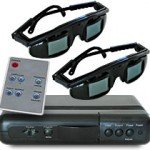 The three dimension imaging is capable of recording three dimensional visual information or creating an illusion of depth in an image. Most of the 3D imaging methods using the stereoscopy method ie presenting a slightly different view of a same image to two eyes. There are two methods to generate 3D images.
The three dimension imaging is capable of recording three dimensional visual information or creating an illusion of depth in an image. Most of the 3D imaging methods using the stereoscopy method ie presenting a slightly different view of a same image to two eyes. There are two methods to generate 3D images.
1. Using colour filter glasses: In this method two images are being super imposed one over other using two filters (One red and other blue). When the viewer put the glasses with red and green colored lens, the images are separated to give a 3D illusion.
2. Eclipse method: In this method a mechanical shutter blocks light from each appropriate eye when the converse eye’s image is projected on the screen. The projector alternates between left and right images, and opens and closes the shutters in the glasses or viewer in synchronization with the images on the screen.
3. Lenticular or barrier screen: This method (New technology) doesn’t require glasses. Both images are projected onto a high-gain, corrugated screen which reflects light at acute angles. In order to see the stereoscopic image, the viewer must sit within a very straight angle that is nearly perpendicular to the screen, limiting the size of the audience. Since this method is not using any additional techniques or apparatus for viewing 3D , this is the most common method used in 3D imaging devices.
The recent development in the 3D devices
3D Televisions
 3-D technology relies on the idea that if separate images are presented to the left and right eyes, the human brain will combine them and create the illusion of a third dimension. TV makers go about this in different ways, though. Panasonic and Sony, which demonstrated their products for CNN at a recent tech expo in Atlanta, Georgia, use “active glasses” and TVs with high refresh rates to achieve the effect.
3-D technology relies on the idea that if separate images are presented to the left and right eyes, the human brain will combine them and create the illusion of a third dimension. TV makers go about this in different ways, though. Panasonic and Sony, which demonstrated their products for CNN at a recent tech expo in Atlanta, Georgia, use “active glasses” and TVs with high refresh rates to achieve the effect.
Two images, one for the right eye and one for the left eye, alternate quickly on the TV. Shutters on the 3-D glasses swap the viewer’s vision from right eye to left eye at the same rate: 120 hertz, or 240 hertz for the images together. The TV connects with the glasses through a sensor that’s placed between the lenses on the glasses.
Sony and Panasonic say they will release home 3-D television systems in 2010; Mitsubishi and JVC are reported to be working on similar products. These next-generation televisions would be able to play shows in 2-D or 3-D. They also would be able to show video games in 3-D, which Sony demonstrated at the expo in Atlanta.
Samsung has incorporated the three dimension technology to their high Definition Digital Light Projection TV (HD DLP).
Web Cam
“Minoru” is the world’s fist consumer 3D webcam. Through this your friends and family can now see you in 3D over your favourite messaging program like Windows Live Messenger, Skype, AOL instant messenger, OoVoo and many others. You can also take 3D photos or even shoot 3D videos and upload them to YouTube.
This connects easily to PC’s USB port just like any other webcam but that’s where the similarities end. The Minoru software has stereoscopic anaglyphic processing that lets you be seen in three dimensions. The red and cyan anaglyph image produced by Minoru can be viewed by anybody who is wearing commonly available red and cyan 3D glasses (five pairs included free with Minoru). Minoru can also be used as a standard 2D webcam for anyone who doesn’t have the 3D glasses at hand.
Demo video of Minoru 3D webcam
Camera
 Fuji Films has recently announce the launch of a new 3D digital camera using an image capture system comprising two Fujinon lenses and two CCDs. Then technology in the 3D digital viewer lets you view 3D images without the aid of special glasses – just your eyes! Not only 3D images but also 2D photos can be shown in vivid detail on the large LCD.
Fuji Films has recently announce the launch of a new 3D digital camera using an image capture system comprising two Fujinon lenses and two CCDs. Then technology in the 3D digital viewer lets you view 3D images without the aid of special glasses – just your eyes! Not only 3D images but also 2D photos can be shown in vivid detail on the large LCD.
Monitors
Several companies are already selling 3D monitors in the market using different technologies. Many of these new products don’t require glasses. Sanyo has come up with a prototype glasses-less 3D monitor that can simultaneously provide two different TV programs–one for a person on the left and one on the right–according to Goro Hamagishi, a researcher at the company. With this technology, a person in the passenger seat of a car could watch a movie while the driver could observe a 3D map, complete with skyscrapers, churned up by a GPS service and thereby navigate by sight rather than address. IZ3D is supplying the3D monitors targeted to gamers.
3 D films
The super hit 3D movie Avatar by James Camerone has given the new dimension to 3D and animation technology . In this film instead of conventional 3D spectacles with red and green glasses, audiences to wear polarized glasses – where each lens lets through a slightly different kind of light. This means that your left eye and right eye can see different images shown simultaneously on the screen – and not only are they less headache inducing than in the past,they look much more like ordinary specs too.
3D Laptop
Few months back the leading computer manufacture Acer has launched a 3D laptop Aspire 5738G. A special 3D layer on the top of the screen facilitate the 3D viewing which doesn’t cause any nasty side effects when you’re not using the 3D glasses.

Virtual 3D converter
This device converts a standard 2D video image into a true, holographic-like 3D projection – in real time. You can now watch virtually all of your favorite TV shows and sporting events, your entire collection of VHS and DVD movies in 3D. The set includes a converter and a special spectacles to view.

RELATED POSTS
View all
